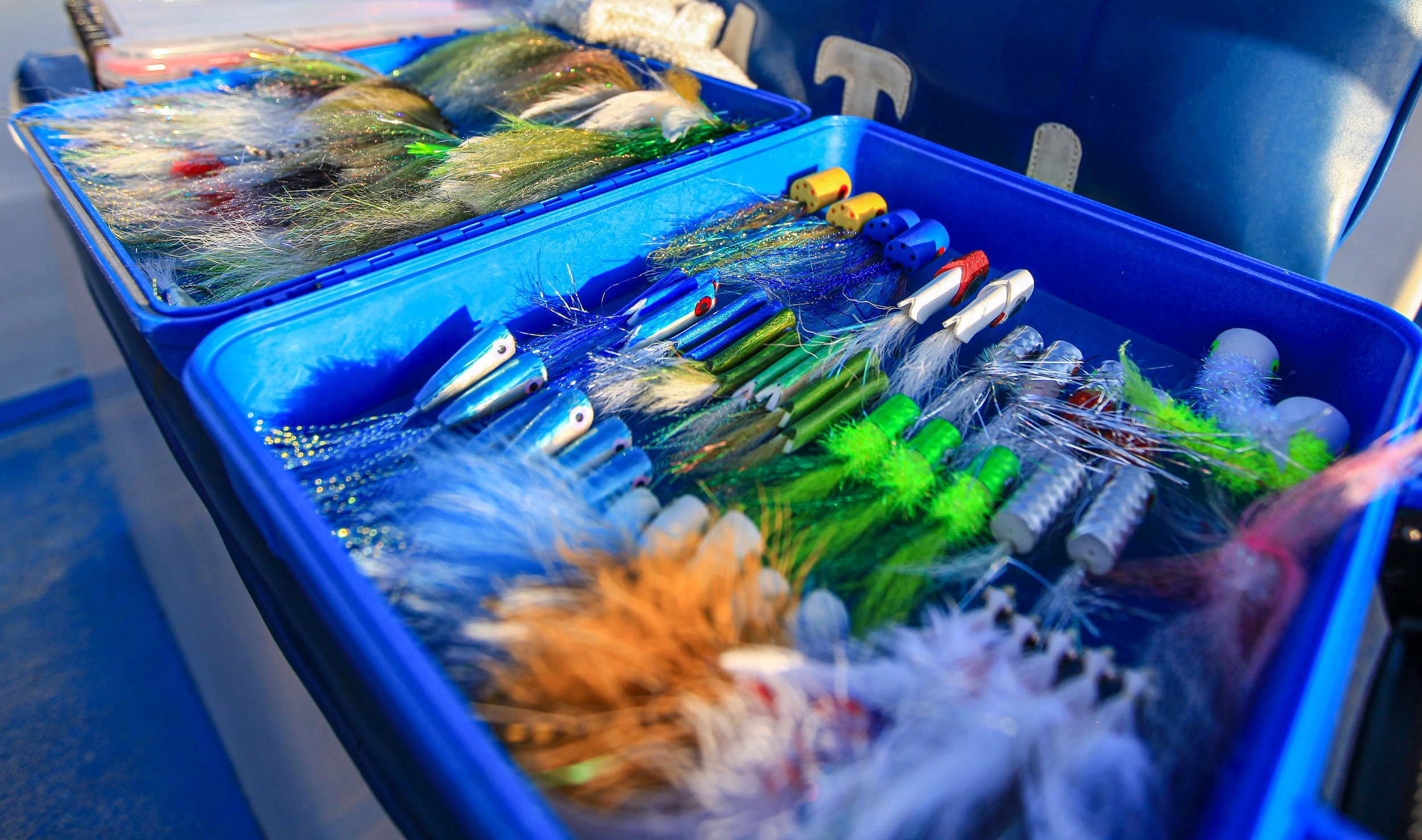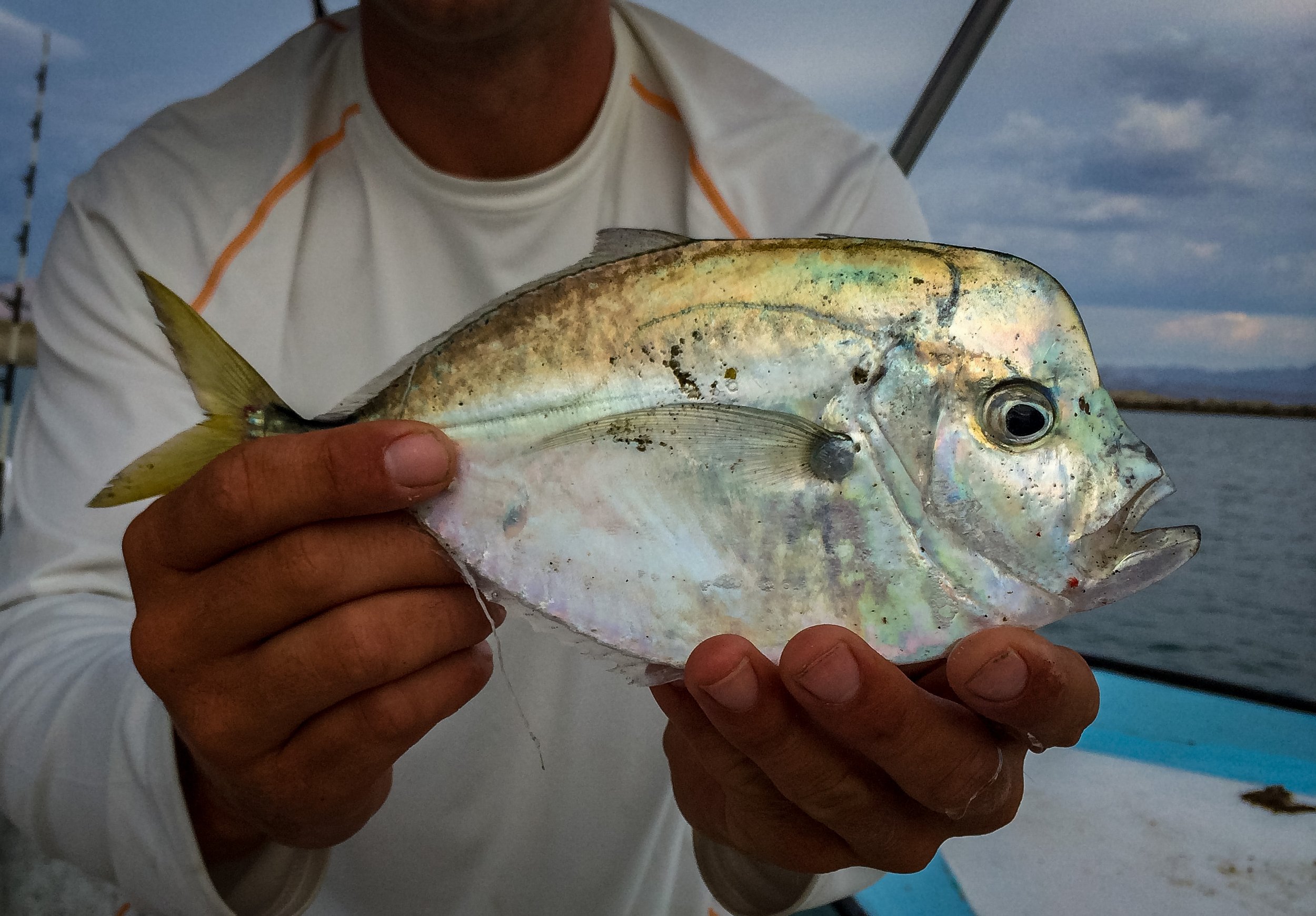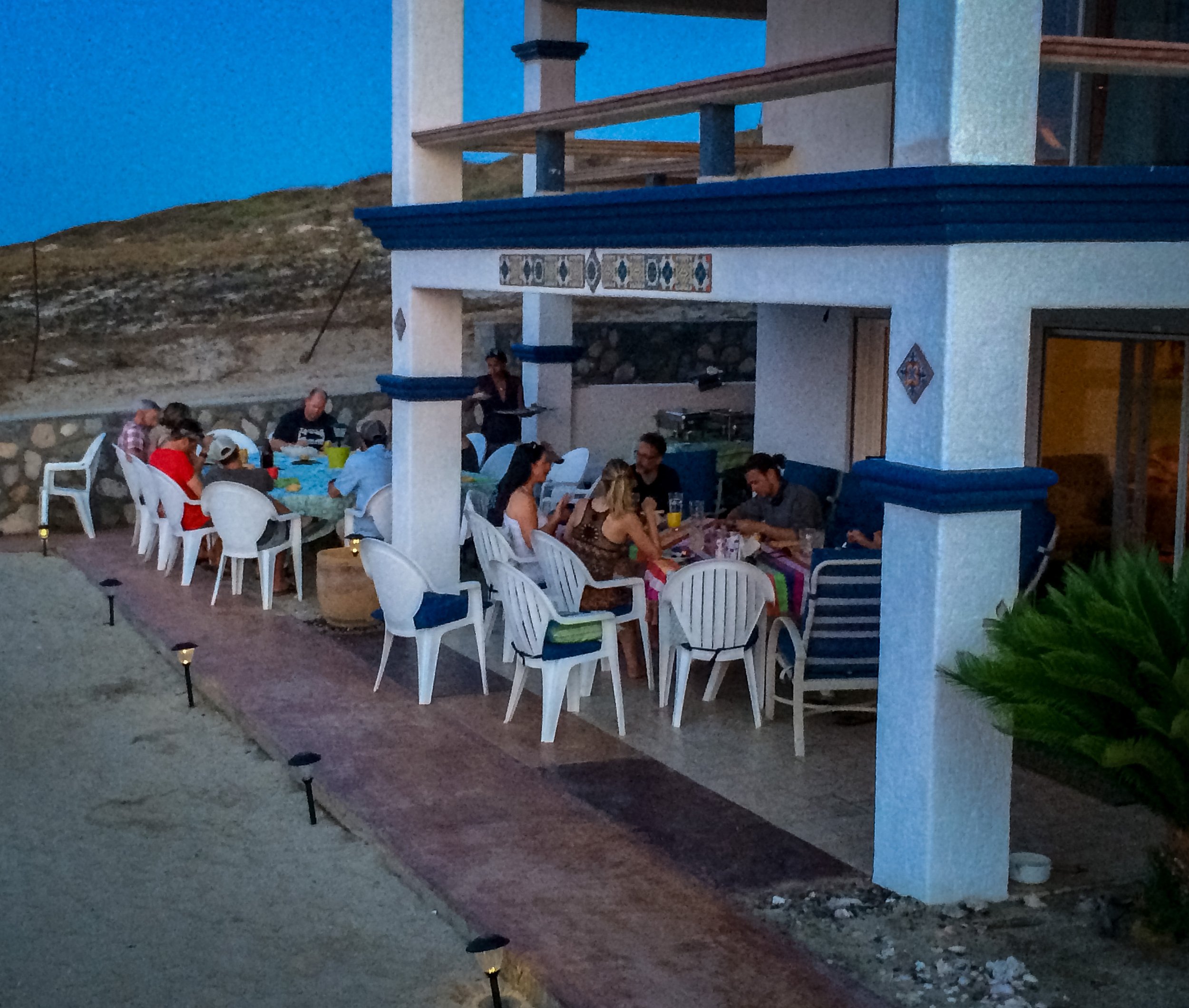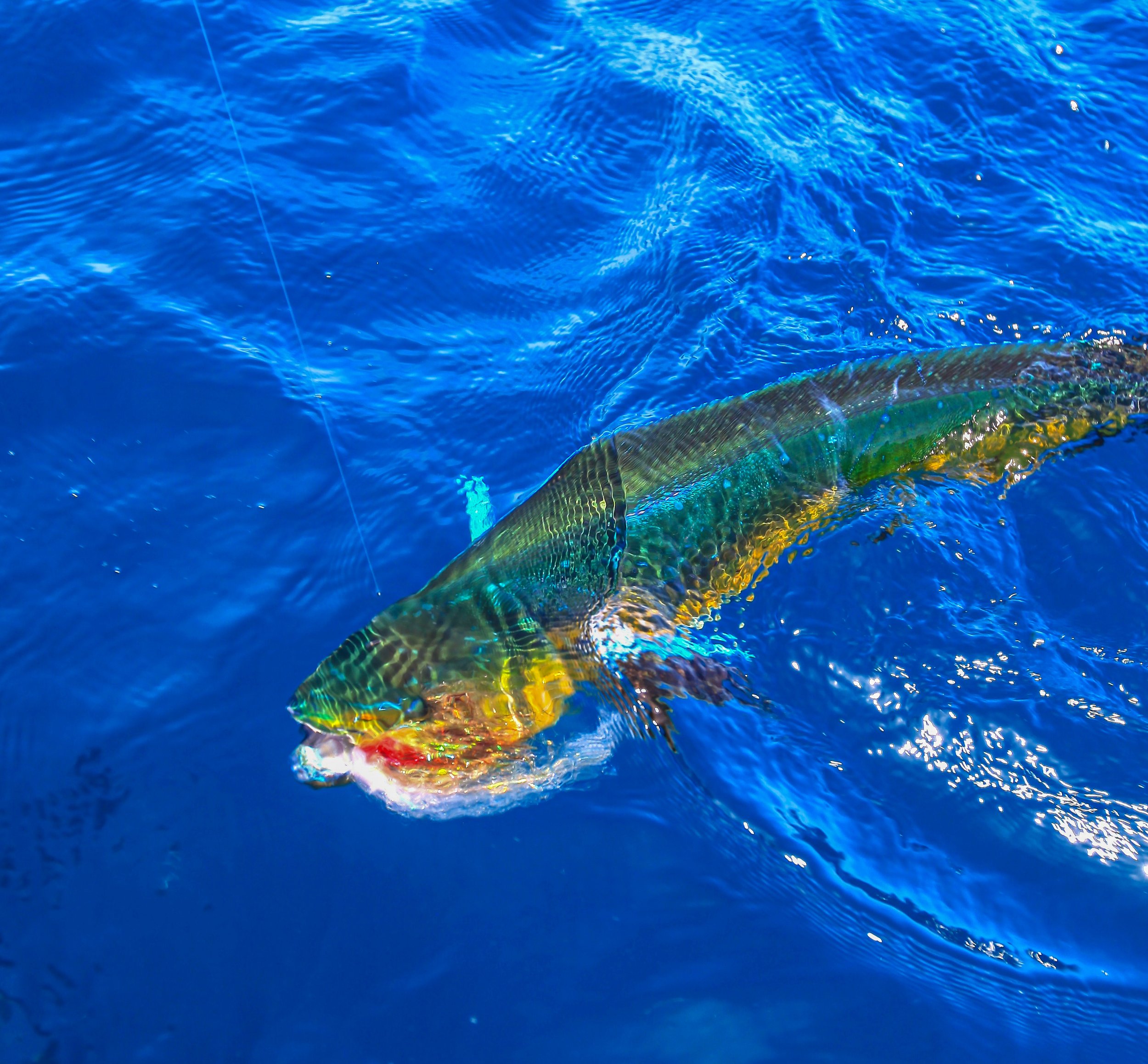The Baja Fly Fishing Experience
Words by Rebekka Redd
Captivating is the first word that comes to mind when thinking of fly fishing in Mexico's Baja California del Sur, also known as "Baja" by locals and seasoned travellers. The breathtaking scenery is a study in contrasts. Cracked, jagged black mountains rise from the deep turquoise sea.
Dusty roads go across miles of sagebrush and succulents. The environment appears harsh and savage, yet travelling across this desert has its own rewards. Go far enough south, east, or west, and the desert gives way to one of the richest ocean environments in the northern hemisphere. Where the sand meets the sea, weary travelers are met with a cool breeze and maybe even a frosty margarita.
For the traveling fly fisher, Baja offers multiple destinations, each with its own unique character. Popular sport fishing areas include Loreto and Cabo San Lucas, but the true mecca for fly fishing is a small fishing village partway up the peninsula on the Sea of Cortez called Los Barriles. The town is located in an area commonly referred to as the East Cape, a popular sport fishing, diving, and windsurfing destination. Although wind and storms during late summer can create rough seas and make fishing difficult, in general, the Baja peninsula acts as a buffer between the open ocean and the Sea of Cortez, creating ideal conditions for fly fishing nearly year round. Some days, the crystal clear water can be as flat and calm as any lake, allowing beach-bound anglers to spot and cast for the elusive and beautiful roosterfish.
Destination
Pursuit Anglers is a sport fishing guide service located on the beach just south of Los Barilles. Their beach house and main headquarters are less than an hour from the San Jose del Cabo airport—the primary port of entry for most travellers—and are ideally placed near numerous superb hotels and resorts should anglers not choose to stay at the Pursuit property.
Josh Kerr, the owner and chief guide, specializes in guiding fly fishing customers to massive roosterfish from the beach, as well as inshore or offshore species from pangas and sport cruisers. Josh has 15+ years of guiding expertise in Baja waters and a trusted team of skilled, pleasant guides and captains that know how to put big fish on the end of your line.
For fly anglers seeking the ultimate challenge, there is no better place to sight fish for roosterfish from the beach. Smack in the middle of a stretch lovingly referred to as "roosterfish alley," the Pursuit compound is flanked north and south by miles of sandy beaches. Guests have caught fish right off the beach in front of the property, but a short drive down the beach on an ATV will put anglers into the real action.
Fishery:
Don’t expect roosterfish to come easily though; this type of fishing is not for the faint of heart or those out of shape. Long hours in the sun and sprinting up and down the beach after cruising fish are the norm, as is being refused again and again by wary roosters. For some anglers, there is nothing more exciting than spotting that big dark shadow cruising along in the shallow water, running full speed to get in position and making the cast for one of the most amazing fish that can be caught on the fly. Those who are dedicated and put in the time to hone their presentation are eventually rewarded with a great battle and, hopefully, an up-close encounter with "Pez Gallo".
Roosterfish can also be caught by fly anglers fishing inshore from small sport fishing vessels called Pangas. A popular tactic is to troll a live mullet until a fish shows up to "play" and then use a bait and switch method to tease the fish into striking the fly. This method is not only effective, but it presents a fun and exciting challenge to fly anglers, as timing a good cast and fooling a roosterfish is never easy. It may not be your typical fly fishing strategy, but even the most discerning of fly anglers will be reaching for the 10 weight when a big rooster blows up on the bait in plain view behind the boat.
If roosters aren’t around, the Sea of Cortez offers a variety of species for year-round enjoyment by fly anglers. At times, the unique underwater topography in the Los Barriles area creates a sports fishing haven where a deep sea trench runs right up against the shore, and at other times, offshore species like tuna and marlin can be caught within sight of the beach. Pangas are an ideal way to reach good fishing, and most of the fly fishing done from boats is done close to shore. During the spring, which is considered a prime fishing time in Baja, roosterfish, dorado, jacks, sierra, and skipjack are all common catches, along with the occasional snapper or ladyfish.
Dorado are a favorite to catch on the fly. They put up a great fight, take flies with abandon, and with their dazzling colors, they rival any fish in the world for beauty. They can be caught by trolling, teasing with a bait and switch method, and even by looking for diving birds or schools of porpoise, which can indicate a school of baitfish that has been pushed to the surface in a feeding frenzy. Another common tactic captains use is to look for floating debris, buoys, or other surface objects. A hungry dorado will often seek out the smallest piece of floating shelter, and a popper or a few sardinas tossed next to the structure can sometimes result in an electric explosion as a hungry dorado erupts from the blue depths. Dorado remain a staple for Baja’s sport fishing fleets due to their high breeding productivity and rapid growth rates, which make the species a reliable and sustainable target for sport harvest. While many anglers practice catch and release, keeping a fish or two for the dinner table is not out of the question. There is nothing quite like a plate of fresh sashimi made from the day's catch!
Offshore, there is more fun to be had fishing from larger sport cruisers. Many of the same species, such as dorado and skipjack, are present in the blue water, but the ultimate prize is a big tuna, sailfish, or marlin, all of which can be caught on flies by the adventurous angler. One of the greatest thrills is to find a school of tuna working with porpoise or busting bait underneath diving frigate birds. Imagine hundreds of porpoises swimming all around and doing flips out of the water as birds dive bomb bait from the sky and big yellowfin tuna work the water into a froth in all-out mayhem. A good baitfish pattern tossed into the melee is sure to put a bend in the rod and get ready for a fight! A small 10–20 lb tuna, or "football," as Josh likes to call them, can keep you working for quite a while, and larger fish have been known to take hours to land, even on a stout 14 wt, which is what you’ll need for chasing tuna or billfish.
The Sea of Cortez is world-renown for its marlin fishing, and Los Barilles is one of the best areas to target them due to the proximity of blue water to shore. The game for fly anglers is bait and switch. Captains will use outriggers on the sides of the cruiser to create a spread of teasers to attract the fish to the boat. When a fish shows up in the spread, be ready for action. Casting a 10" fly on a 14wt is no easy feat, but if you manage to put the fly in front of the fish, the battle is on! Sailfish are present too, and while not as prevalent as marlin, the speedy torpedoes are a welcome surprise to any offshore fisherman.
Equipment:
The fish in Baja are big and tough. To be able to cast the larger flies and lines and have a chance at landing these brutes, anglers will need the proper equipment.
Although there are many rods that will work for specific purposes, if there were only one outfit to pack on a trip to Baja, it would be a 9’ 10wt fast action rod and a matching reel with a high quality drag and a deep spool. Add at least 300 yards of backing and a good tropical intermediate line and you would be set to chase almost any species here. This setup is ideal for roosterfish from the beach and quite adequate for inshore species, such as small dorado and tuna.
For bigger dorado and any offshore fishing, a 12wt is the bare minimum and a 14wt is even better. A heavy duty reel with a good drag, 400yds of backing and a full sinking shooting head will complete the offshore outfit.
It is wise to bring extra spools with different lines for varying conditions. Fast sinking lines can work better than intermediates if it is windy on the beach, or if fish are deep when working from the boat. Dorado are especially fond of poppers, and a good floating line can set you up for loads of fun when they are around in good numbers, although intermediate lines will work for this too. Make sure the line is a tropical line and that it matches the rod. Forward-weighted lines and shooting heads with aggressive tapers are ideal for casting big, wind-resistant flies and loading the heavy rods needed to tackle big fish.
Leaders also have to be up to the task of flinging big flies and landing big fish. There aren’t many commercially available pre-packaged leaders that will do the job, so it is best to bring spools of leader material and either tie your own or let the guides tie them for you. For beach fishing, a short, 6-7 foot fluorocarbon leader with a 40# butt section tapered down to a 20# tippet is perfect. This same leader will work quite well when fishing inshore from Pangas.
Offshore leaders are more specialized and require skill with knots to rig. A good setup for billfish is a short 5’ leader with a 50# butt section and 20" of 80-100# shock tippet. There are some similar pre-tied leaders that are commercially available designed for tarpon fishing that will work.
Key Tips:
Casting 10wt + rods and large flies is not common practice for most anglers. Add wind, nerves, and waves into the mix and you have a recipe for frustration if you are unprepared. If you are able, taking a 10wt out to a field or body of water for some practice before your trip is highly recommended. While a good long-distance cast can be an advantage when fishing from the beach, being able to cast accurately and quickly over short distances--typically 40 feet or less--will have you hooking fish more consistently than being able to bomb out an 80-foot hero cast.
A good way to practice is to start with short, 20-foot casts, just picking up the line and laying it back down. Focus on stopping your backcast abruptly with the rod tip high and make sure to give the heavy rod ample time to load. Do this until you are comfortable with the rod, can form a nice, tight loop and get relatively close to a target. Then do the same thing at 30 feet, 40 feet, and so on. If you begin to struggle, step it back a notch and start over. It is easy to forget about good casting fundamentals when planning for a trip, and even easier to forget during the excitement of teasing up a hot dorado or spotting a rooster on the beach. A solid base of practice can mean the difference between an awesome or frustrating trip. If you are struggling with the heavier rod, there are many qualified instructors who can help get you up to speed. Check with your local fly shop or club to find someone who can work with you, and be sure to tell them what your fishing plans are.
It is hot down in Baja, and you will be spending a lot of time in the sun. Drink plenty of water, and make sure to come prepared with sunscreen and the proper attire. A good hat, buff, and lightweight long-sleeved fishing shirt are indispensable, and your skin will thank you at the end of a long trip. Don’t forget to cover your legs and feet!
As most of the fishing is highly visual in nature, a good pair of polarized sunglasses is a must. Dark and mirrored lenses that help filter out the bright sun will keep your eyes comfortable so you can spot fish. They will also help if an errant cast happens to put that 5/0 saltwater hook a little too close to your face.
Some anglers prefer sandals or booties for fishing off the beach. The sand is hot, and there are spiny puffers and other hazards that you can step on. Josh and his guides prefer to fish barefoot, however, so that they can feel if they are standing on their line or if it is tangled around their feet. If this is your choice, flip flops should be just fine.
Wrap up:
While some anglers can be put off by the unconventional methods and heavy tackle required for fishing inshore and offshore in Baja, it presents a unique and exciting challenge for the open-minded fly fisher. The visual element of the fishing and the adrenaline packed moment when a fish lights up on the fly more than make up for any lack of "purist" delicacy. With so many species to target and techniques to become acquainted with, fly fishing in Baja is as diverse as it is exciting.
Give it a shot, and hopefully your next fishing adventure will be filled with doubled rods, screaming drags, and big fish. ~ Rebekka






























